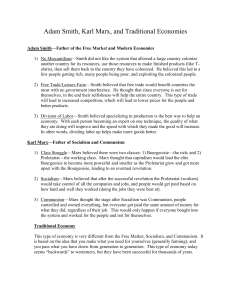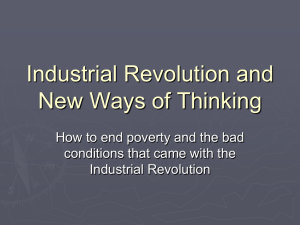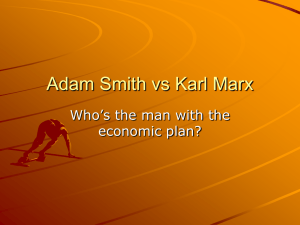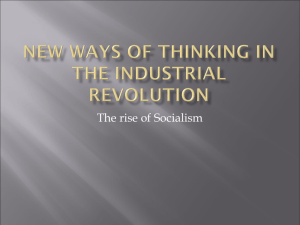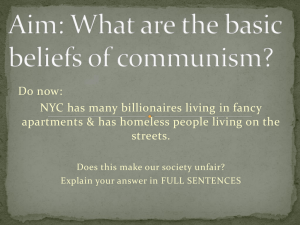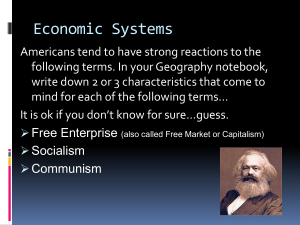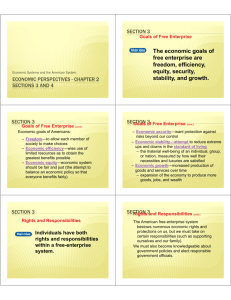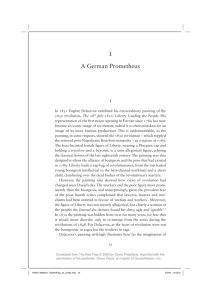Test-Basic Econ Concepts 1-30.doc
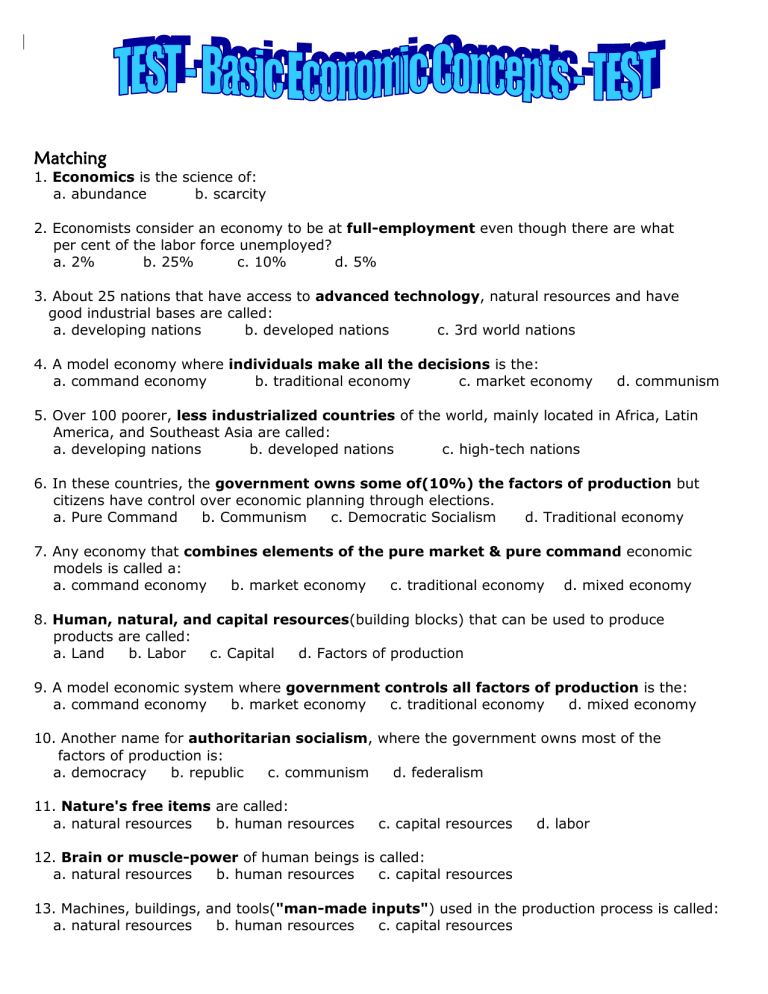
Matching
1. Economics is the science of:
a. abundance b. scarcity
2. Economists consider an economy to be at full-employment even though there are what
per cent of the labor force unemployed?
a. 2% b. 25% c. 10% d. 5%
3. About 25 nations that have access to advanced technology, natural resources and have
good industrial bases are called:
a. developing nations b. developed nations c. 3rd world nations
4. A model economy where individuals make all the decisions is the:
a. command economy b. traditional economy c. market economy d. communism
5. Over 100 poorer, less industrialized countries of the world, mainly located in Africa, Latin
America, and Southeast Asia are called:
a. developing nations b. developed nations c. high-tech nations
6. In these countries, the government owns some of(10%) the factors of production but
citizens have control over economic planning through elections.
a. Pure Command b. Communism c. Democratic Socialism d. Traditional economy
7. Any economy that combines elements of the pure market & pure command economic
models is called a:
a. command economy b. market economy c. traditional economy d. mixed economy
8. Human, natural, and capital resources(building blocks) that can be used to produce
products are called:
a. Land b. Labor c. Capital d. Factors of production
9. A model economic system where government controls all factors of production is the:
a. command economy b. market economy c. traditional economy d. mixed economy
10. Another name for authoritarian socialism, where the government owns most of the
factors of production is:
a. democracy b. republic c. communism d. federalism
11. Nature's free items are called:
a. natural resources b. human resources c. capital resources d. labor
12. Brain or muscle-power of human beings is called:
a. natural resources b. human resources c. capital resources
13. Machines, buildings, and tools("man-made inputs") used in the production process is called:
a. natural resources b. human resources c. capital resources
14. The way nations answer the three basic questions determine their:
a. natural resources b. economic system c. style of government d. leader of nation
15. Goods and services are called:
a. needs b. wants c. products d. profit e. trade-off
16. Goods or services that are necessary for survival are called:
a. needs b. wants c. products d. profit e. trade-off
17. The choice or decision that is made when a resource is used to produce one item and
cannot be used to produce another item is called a:
a. opportunity cost b. want c. need d. trade-off e. product
18. Goods or services not necessary for survival are called:
a. needs b. wants c. products d. profit e. trade-off
19. When a choice(decision) is made and a first choice is picked over a second choice, the
2nd best choice[best alternative foregone] is called the:
a. opportunity cost b. want c. need d. trade-off e. product
20. Finished products meant for immediate consumption are called:
a. capital goods b. consumer goods c. traditional goods
WRITE THE LETTER OF THE ITEM THAT
DOES NOT
BELONG
WITH THE FIRST ITEM.
21. Three basic economic questions:
a. What goods and services should be produced?
b. How should goods and services be produced?
c. Why should goods and services be produced?
d. For whom should goods and services be produced?
22. Mbuti Pygmies:
a. live in the Ituri Forest of Zaire
b. belong to a traditional economy
c. are food gatherers and hunters
d. belong to a command economy
23. Characteristics of capitalism:
a. closest to the pure-market model.
b. individuals own & control almost all of the factors of production.
c. government intervention is limited.
d. profits are limited.
24. Characteristics of authoritarian socialism(communism):
a. closest to the pure-command model
b. government owns and controls almost all of the factors of production
c. often includes five-year economic plans for the use of the nation's resources
d. based on Adam Smith's the The Wealth of Nations
25. Features of the U.S. economy:
a. private property
b. freedom of enterprise(business)
26. Entrepreneur: c. unlimited government interference d. limited government interference
a. attempts to start a new business c. risks failure in return for financial gain
b. attempts to introduce a new product d. has absolute control over the resources of a manor
27. Democratic socialism:
a. Government owns and controls some of the factors of production(about 10%)
b. Rigid central planning by government directs the economy
c. Individuals elect government officials
d. Individuals have basic human rights
28. Adam Smith:
a. attributed economic growth to the invisible hand of self-interest
b. was one of the first people to attempt to explain how the market operates in a pure market
system
c. believed producers must sell the right products at the right prices in order to maximize profits
d. was the founder of socialism
29. Three types of model economic systems:
a. Pure Command b. Private c. Pure Market d. Traditional
30. Traditional economy:
a. Customs are strong
b. Much technological change
Matching
c. Looks to the past d. Change is resisted
31. When resources do not satisfy needs or wants, this is called:
a. abundance b. consumers c. scarcity d. opportunity cost
32. The study of the choices people make in an effort to satisfy their unlimited needs & wants
from limited(scarce) resources is the definition of:
a. biology b. chemistry c. economics d. career decisions
33. People who wish to buy goods and services are:
a. producers b. suppliers c. consumers d. entrepreneurs
34. This diagram shows how resources, products, and payments are exchanged in the U.S.
a. production possibilities curve b. circular flow c. AD/AS graph d. AE graph
35. Economic system in which business can be conducted freely with only limited government
intervention is:
a. communism b. democratic socialism c. free enterprise system
36. This person believed that without governmental interference the market is controlled by
the invisible hand of self-interest.
a. Karl Marx b. Fredrich Engels c. Mark Morris d. Adam Smith e. Randy Becker
37. This was Karl Marx's term for workers(who were in bondage) in a capitalistic society.
a. entrepreneur b. bourgeoisie c. proletariat d. pygmies
38. Along with Friedrich Engels, wrote The Communist Manifesto, the first book on communism.
a. Karl Marx b. Mark Morris c. Adam Smith d. Randy Becker e. David Post
39. This is the person who combines land, labor, and capital to produce products.
a. pygmy b. proletariat c. bourgeoisie d. entrepreneur
40. This was Karl Marx's term for the owners in a capitalistic society.
a. entrepreneur b. bourgeoisie c. proletariat d. pygmies
In this
Circular Flow Model
, choose an answer from the right column that goes with the
proper flow
.
41. Flow #1
42. Flow #2
43. Flow #3
44. Flow #4
In this Production-Possibilities Curve:
A. Consumer spending
B. Firms make payments [rent, wages,
Interest, and profits]
C. Products (goods/services) are sold
D. Households sell resources [land, labor,
Capital, and entrepreneurial ability]
45. At what letter can you get the most capital goods?
46. What letter represents an advance in technology?
47. At what letter(if a country were producing there now)
would there be the most economic growth in the future?
48. What letter represents a recession[idle resources]?
49. At what point can you get the most consumer goods?
C
A
P
I
T
O
L
A
D
B
C
E
50. The frontier line in the diagram(curve rather than a
straight line) indicates that the 2 products are:
a. "equally substitutable"[constant cost]
b. an example of "The law of increasing cost"
Consumer Goods
Test 1
Basic Concepts
Ch 1 & 2
[1-49]
35. C
36. D
37. C
38. A
39. D
40. B
41. C
42. A
43. B
44. D
45. A
46. E
47. A
48. D
49. C
50. B
26. D
27. B
28. D
29. B
30. B
31. C
32. C
33. C
34. B
1. B
2. D
3. B
4. C
5. A
6. C
7. D
8. D
9. A
10. C
11. A
12. B
13. C
14. B
15. C
16. A
17. D
18. B
19. A
20. B
21. C
22. D
23. D
24. D
25. C
